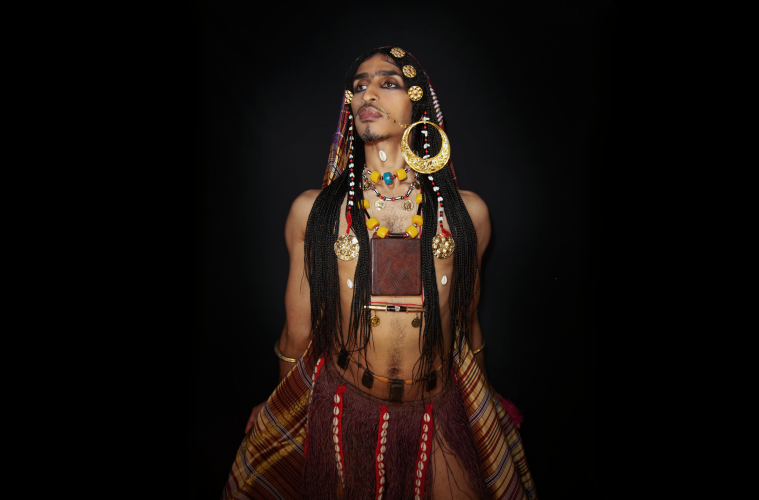Interview by: Jamal from JINS podcast
Images by: Ahmed Umar
Translated into Arabic by Nawara B.
This article is part of the “My Hair My Hair” issue
At the intersection of many identities, Ahmed Umar (he/she/they) is a talented cross-disciplinary and performance artist. Drawing on their non-binarity, complex upbringing between Sudan and Saudi Arabia, and life in Norway, Umar works between mediums and platforms to navigate themes of identity and culture, gender and sexuality, religion and authority. They play with rules of the mind and body, as seen in their 2022 exhibition in Oslo, “Ruqyah رُقيَة” (also featured on our cover), which centers around the invocation of the name of Allah to alleviate afflictions, both physical or spiritual.
The richness of Umar’s background and artistry has been captured in a documentary on his life, The Art of Sin (2020). Additionally, they share their story in a self-authored chapter in This Arab Is Queer (2022), an anthology by LGBTQ+ Arab writers edited by Elias Jahshan that was just released by Al Saqi Books. In both, you see that at times heart-wrenching stories behind the artworks don’t detract from the flamboyance of his work and persona, but rather fuel it.
When viewing his art, you will notice Umar’s attention to detail and the centrality of hair to his approach whether in his work oh he expresses it on social media. Hair is, indeed, a medium of self-expression, one that is both reigned in by convention and explored into potentially rebellious, subversive, and empowering ends. In many ways, hair is a queer language, a form of communication for those who cannot speak openly about their identities. Umar’s use of his own hair is mesmerizing.
In this interview, Ahmed Umar speaks about their hair practices and their role in reformulating and commenting on his relationship with himself, his culture, and his upbringing in his art.
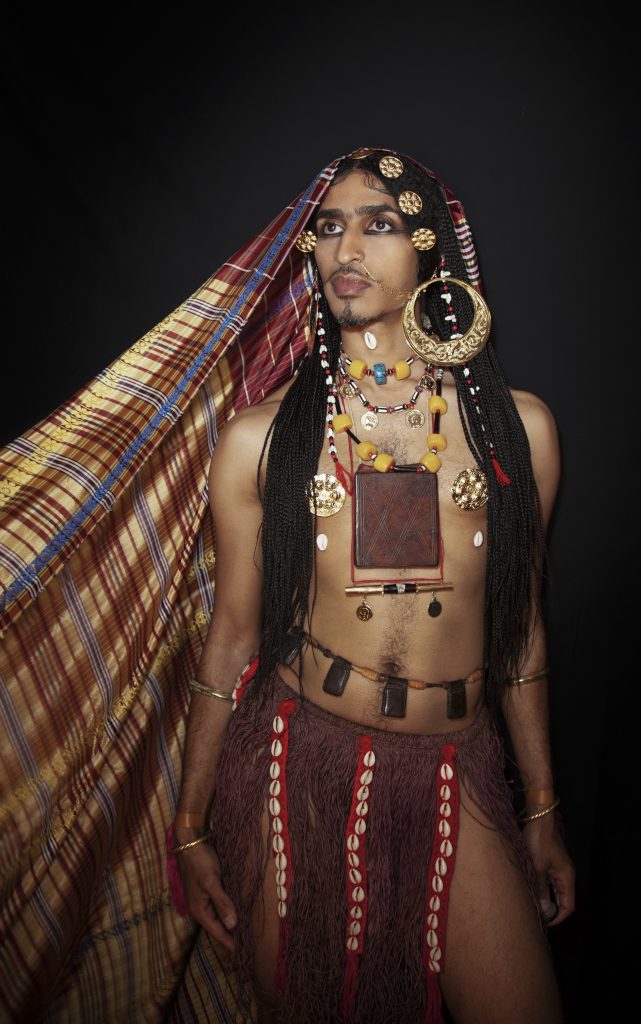
Images by Ahmed Umar
Before we jump into your work and accomplishments as an artist and performer, can you tell us a bit more about your background and how you got to where you are today?
I grew up between Saudi Arabia and Sudan. During my teenage years, I lived in a very conservative family that wanted to live close to the Holy Mosque, in Mecca. In Sudan, I lived within a quite established traditional Sufi family.
My journey started from the moment I came out as gay, after many years of questioning my identity. Family members didn’t just turn their backs on me, they could also raise their swords on me. The older I got, the harder it was to be disconnected from my sexual orientation. I tried as much as I could to change it by praying, but in vain.
My identity emerged in sync with my art. I find art inseparable from my queer identity, and inseparable from my whole being. Art deals with my feelings, and I never saw myself as something but an artist. Through the years, it gave me a fluent language that I could speak. I could be defined as a queer artist, but at the end of the day, it’s just art made by a queer person.
Being queer in Sudan is both socially taboo and illegal – Article 148 of the Sudanese Penal Code punishes sodomy. You’ve spoken about how painful it was to be rejected by your country and family, but also talk about moving forward. In a live performance you did in Oslo in 2013, you said “If you no longer have a family, make your own in clay.” This is such a powerful message – can you say more about it?
This performance is stemming from a local proverb about mean people, that literally says “you in clay would be better than you,” because clay is worth nothing. My approach was to reform the negative emotions that you get from people and throw them away.
My cousin was congratulating me on my art, but when he saw me come out on my Facebook post, he turned and said I was a “piece of shit” and that he will never be proud of someone who shakes the throne of Allah. Family changes its behavior overnight. He was one of the family members I sculpted, along with my brother and the most painful one, my father.
In your work, you often mix and rework tradition and heritage from Sudan to produce something new. Your 2016 artwork, “What Lasts! (Grave),” lies at a crossroads between pharaonic and Islamic influences – you built a sarcophagus for your body to imitate the pharaohs of ancient Sudan, and created a grave with different letters written in Arabic. This piece and how you came up with the idea?
This artwork is part of a triptych created in response to reactions to my coming out of the closet. Some important family members wished me dead, and I wondered what really lasted in life if even family relationships and life memories were thrown into the fire.
The artwork talks about how destructive it can be to be denied of your own identity. I molded my whole body in paper and then draped all the letters from a Quranic verse about alleged homosexuality over the sarcophagus. I glazed it with white paint and set fire to it in the ceramic kiln. After having burnt, what lasts is the verse and queer people’s bones.
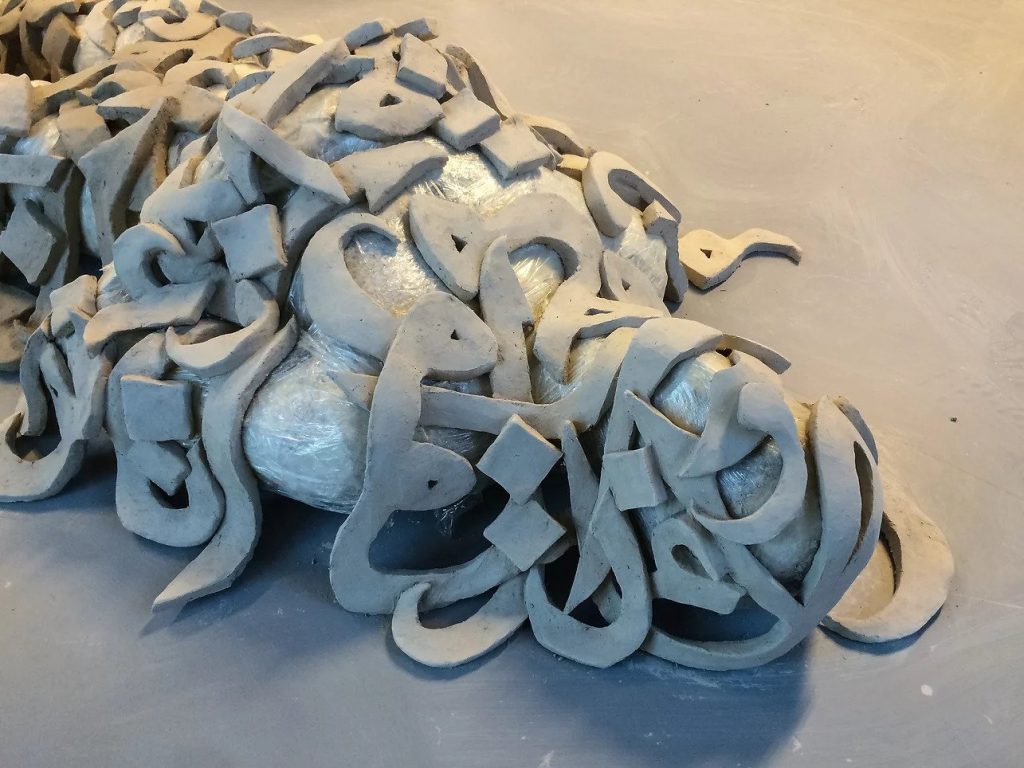
Sculpture ‘What Lasts! (Grave)’ by Ahmed Umar, 2016
You have lived in contexts that are animated with beliefs in Islam and more superstitious things like djinns, curses, and so on. How do your artworks, like “Hijab (Annual Protection)” (2017), help you negotiate your relationship with these beliefs?
I grew up in Mecca, in the middle of the most Wahhabi community that you can think of. We could not shake hands with non-Muslims, and we were told we would go to hell if we saw even one hair from a woman’s body. Wahhabis fight against everything that can be traced to before the Islamic era. Even prayer beads were forbidden in Saudi Arabic, and teachers would rather me pray with my fingers. The other part of my family is Sufi, and they believe in protection through amulets and spirituality. For such a long time, I was so deep into Wahhabi beliefs that I thought my family was misguided. I ended up so confused.
From 2018 onwards, I studied at the National Academy of Arts in Norway. It gave me another perspective on how I own my story and personalize my artworks, and it pushed me to dare even more. Art, for me, opens eyes and helps us see different narratives.
During the Pride March in 2019, I wore the amulets that Sudanese men would traditionally wear in ceremonies around their waists and biceps. I wanted to both celebrate the Sudanese cultural and tribal heritage and put forward Islamic art. I’m actually working on a big exhibition that is a continuation of the amulet series, with 99 sculptures referring to the 99 prayer beads and the 99 names of Allah.
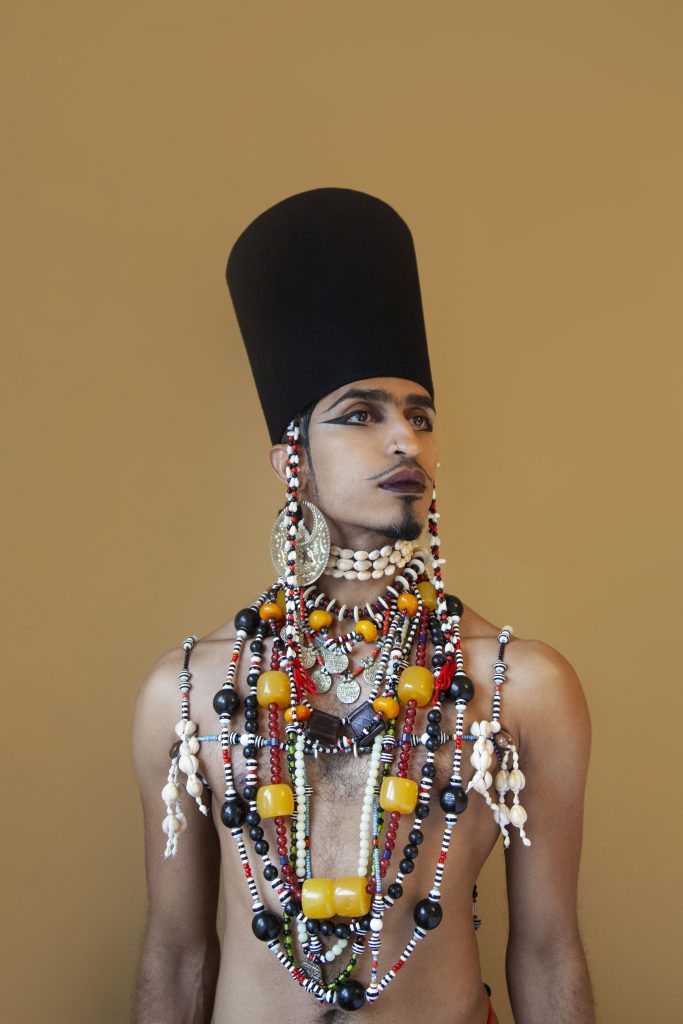
Images by Ahmed Umar
You were recently also featured in the film, The Art of Sin (2020), which documents your specific journey with your hair and upbringing. Can you tell us a bit more about this project? What are the roots of the project and what does it mean for you?
Studying the hate waves and bullying I experienced after publicly coming out, I noticed this sort of repetitiveness when it comes to questioning my sexuality. The same focus on the functionality of my sexual parts, avoiding the emotional part of being gay. I was accused of being a prostitute, a transgendered person, a loser, family-less, uneducated, negatively shameless, and much more.
The ignorance I had to manage throughout my life before moving to Norway hasn’t changed since moving. I recognized the fact that my loss will not be as grave as someone who lives in Sudan, or is economically or emotionally dependent on their family. Therefore, I thought I should do something about that misconception that is still hurting gay people in Sudan. As a community, we have always been spoken about, but never with.
I partnered with Ibrahim Mursal. I share much the same conservative background, religion, color, and age with him, but we differ in who we choose to love. We started with an intention to publish videos on YouTube, and then the idea developed into a whole movie that took four years to shoot. We let our guards down, asked questions, and answered honestly. The type of questions that have been repeatedly asked on my social media, as well as between friends in the streets of Sudan. I wanted to answer these questions directly and cut the power of any third parties. And I intentionally chose to speak in a simple Sudanese dialect, free of big terms and influences from English.
I struggled as a teenager to find a Sudanese person I could relate to. I believed that I was cursed and that Allah would punish me with eternal unhappiness, HIV and die like Freddie Mercury, and that I will bring shame to my family. I wanted so badly to die. I was so lonely. When I fell in love with a guy and he broke up with me, I needed a shoulder to cry on. The only one I could think of who could listen to me without scandalizing me was a person who sexually harassed me!
I will do everything I can so no one would go through an experience like this. And the film is my attempt to say to the teenage me, and everyone who needed to hear: “It is OK, you are not alone. You are good and are loved, you can have a life. You can be successful. Don’t give up”
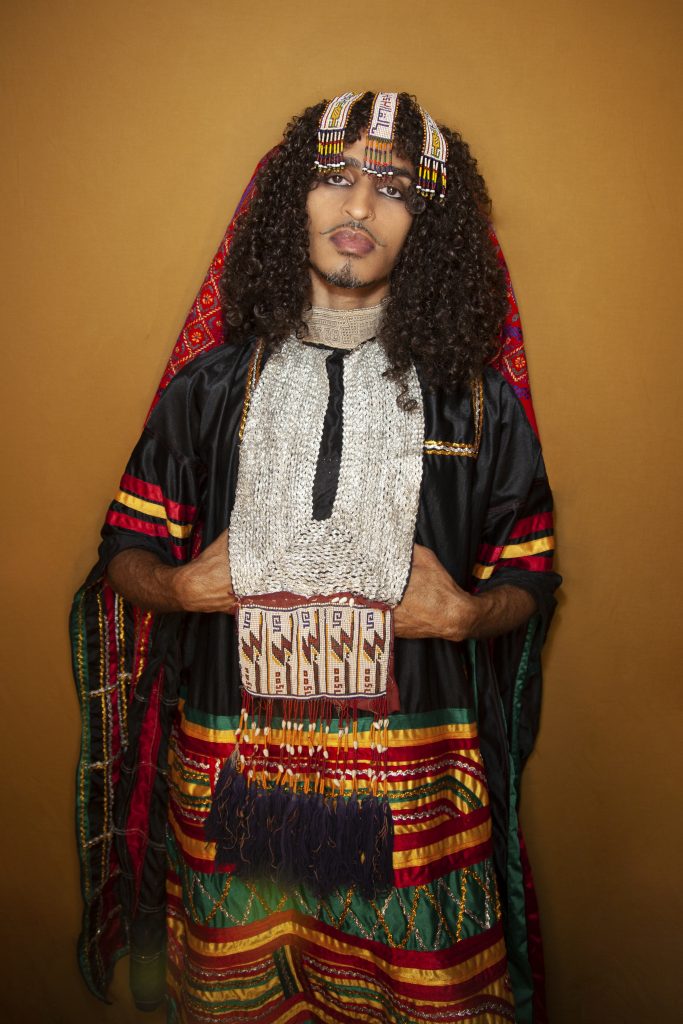
Images by Ahmed Umar
Turning more directly to hair, many of us recognize the role that hair plays in social, political, and religious domains in the region, and that it is central to negotiating gender norms. For you, personally and artistically, how does hair become a medium to express your gender identity and sexuality?
One of the first things that my family in Mecca tried to fight against was my hair – they never approved of my hairdos. It was not normative enough, not like the other boys.
When growing up, I found out that my hair was not nice because it was curly. At school, everyone mocked me because of it, and it was linked to my blackness. It was one of the most racist environments I have ever lived in: they called me a “slave.” Other pupils would take my ghutra (Saudi shawl) and mess with my hair.
After I left Sudan and Saudi, the first thing I did was let it grow. I would style my hair every week and would feel so good, so special and so good-looking. My hair was like a rebel against all these norms that were set for us.
The film, The Art of Sin (2020), documents your specific journey with your hair. There’s a beautiful moment in The Art of Sin (2020), just before you return to Sudan, when you cut your years-old hair in front of the mirror and say to them, “It was a good friendship between us. You have never disappointed me, while everyone did.” What did this hairstyle mean for you, and why did you feel like it was time to cut it off?
It was one of the hardest moments of my life. Shaving off my hair was hard, but I needed to be safe. Having my hair taken by force and knowing that I had to blend in with other people was really heartbreaking. My hairstyle distinguished me from everyone else and it helped me be myself. I felt like this was 100% Ahmed. Also, my ponytail started growing in 2006, and it was like wearing my life story. All the stories of my life were documented through my hair.
In your opinion, what are some of the ways that norms around hair and standards can also be oppressive within queer communities, whether it be linked to contemporary styles, gender norms, signs of aging, etc? What might be some causes for this?
The gay community has been through a lot of oppression for a long time. We face two swords: religion and society/family.
Not that it’s an excuse, but I see why this aggressiveness towards each other happens. I have experienced, more than enough, being shunned by other gay men for my openness, my gender-fluid style, my outspoken-ness about issues we don’t usually talk about. They project the same crocked patriarchic hate they have learned. Sometimes I put them in place, other times I choose to let them take time to heal. The trauma is major.
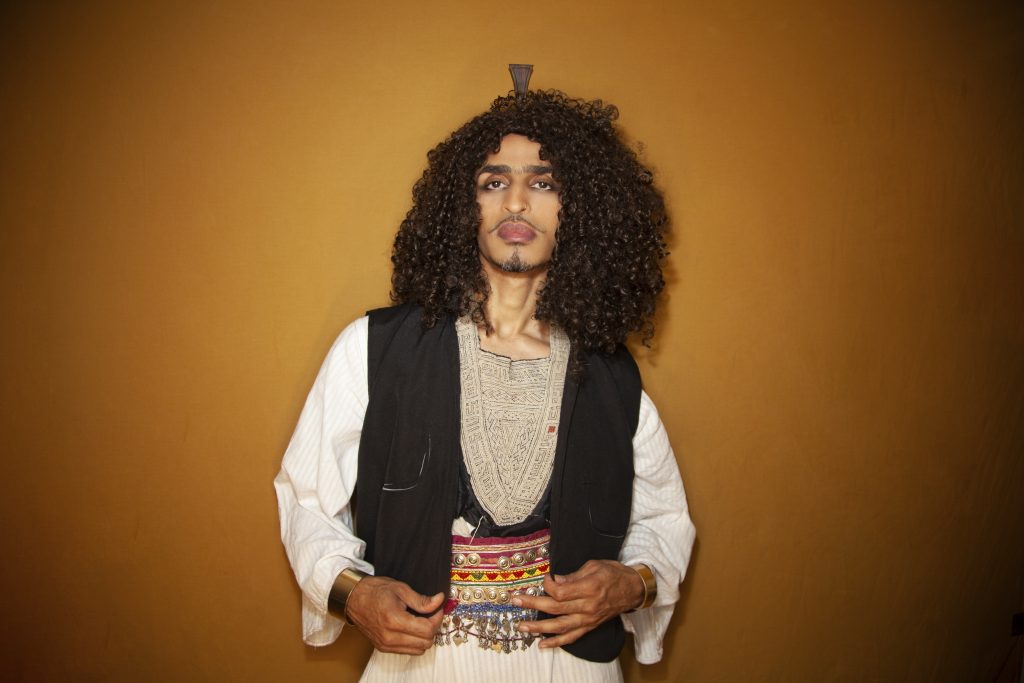
Images by Ahmed Umar
You’ve spoken a lot about how art can be a tool of self-expression and playfulness and a potential source of power and empowerment. Considering, however, that hair can “vanish” or be so curtailed, what other forms of “self-styling” might serve a similar purpose?
In line with the art I make, I use my body as a canvas for communicating. I come to love my body after so many years of untying the knots of insecurity. I listen to its wishes, and I actively work to create them.
That can mean a hairdo that makes heads turn, garments designed for other “genders” or whatever I feel enhances my beauty and delivers the message I want to tell. I am very preoccupied with the idea of communicating my Sudanese-ness in a broad sense. I mash things up from both female and male traditions. And I went to some forbidden zones, like the classical bridal dance outfit from my region of middle Sudan. It is very revealing, very proud, and incredibly beautiful.
And finally, how do you envision the future of the queer and trans community in the region generally, and in Sudan specifically? How does the future of your personal narrative and art fit into that vision? Do you believe in an artistic, queer thawra?
I absolutely believe in a queer revolution, or at least an evolution. Through the years that I have been out, I have seen with my own eyes how people changed. People who bullied me now ask me questions peacefully and ask for forgiveness. They didn’t have any examples of queer people.
Call me naïve, but I want to organize the Nile Pride in 2030, in Khartoum. Now we have the force of social media that spreads information very quickly. If it weren’t for the queer community in Sudan, I would never be where I am today and I would never have been as vocal about LGBTQIA+ rights.

